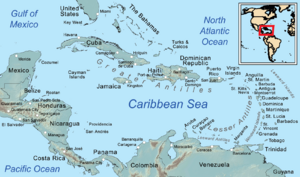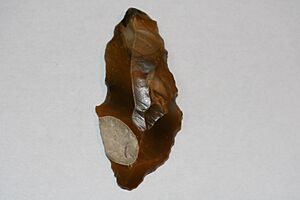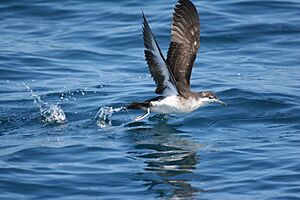Seafaring in the Pre-Columbian Caribbean facts for kids
Seafaring, or traveling by sea, has been super important throughout human history. It helped people move to new places all over the world, especially long ago. In the Caribbean, sea travel was the only way to reach the many islands.
Scientists have found that people settled in the Caribbean Islands long before Christopher Columbus arrived. One big reason they traveled to these islands was to find special materials like flint, clams, and oysters. We don't have many ancient boats left, but we can guess what some of the Caribbean canoes looked like. Old writings also describe how the Amerindian people used their canoes. It's tricky to know if canoes from 500 years ago were similar to those from 5,000 years ago.
Contents
Exploring the Ancient Caribbean Sea
The sea helped people move around and connect with each other thousands of years ago. This was especially true in the Caribbean, where traveling by sea was the only way to reach the islands from the mainland. The Caribbean Islands are usually split into groups: the Greater Antilles, the Lesser Antilles, and the Lucayan Archipelago. The Caribbean Sea is surrounded by these island chains and by North and South America.
It's hard to learn about ancient sea travel because there aren't many written records or old artifacts left. Boats and paddles were made of wood, which usually rots away over time. So, we don't often find clues about how they looked or how they were built. However, when we find similar tools or pottery on different islands, it tells us that people traveled between them by sea.
How People Settled the Caribbean Islands
The Caribbean Islands look like a chain of stepping stones, stretching from North, Central, and South America. This has made scientists wonder when, how, and why people first moved to these islands. This topic has been debated for over a hundred years!
Because many Caribbean Islands are close to each other, early ideas about how people settled them were based on a "stepping-stone" model. This idea suggested that people first arrived on islands closest to the mainland. Then, they slowly moved to islands further away.
However, newer research suggests a different idea called the "southward route hypothesis." This idea proposes that people first settled the northern islands, like Cuba and Puerto Rico, directly from South America. After that, they moved south into the Lesser Antilles. This idea is supported by radiocarbon dates and computer models that show how sea travel might have worked.
First Islands to Be Settled
The very first Caribbean island to be settled was Trinidad. The oldest things found there are from around 8000 BCE (Before Common Era). Back then, sea levels were lower, so Trinidad might have been close enough to South America that people didn't even need a boat to get there. So, Trinidad's early settlement might be different from how other islands were settled.
Scientists have found two main periods when people settled the Caribbean. The first was between about 3850 and 550 BCE. During this time, people settled many islands, including:
- Cuba, Hispaniola, and Puerto Rico in the Greater Antilles.
- Guadeloupe, Sint Maarten, Vieques, Saint Thomas, Barbuda, Antigua, and Montserrat in the northern Lesser Antilles.
- Barbados and Grenada in the southern Lesser Antilles.
- Aruba, Bonaire, Curaçao, and Tobago, which are close to South America.
Other discoveries suggest that more islands were also settled during this early period. These include Haiti, the Dominican Republic, Mona Island, Anguila, Saba, St. Kitts, Nevis, Marie-Galante, Martinique, Margarita, Coche Island, and Cubagua. Evidence from ancient fires also shows that by 3190 BCE, many islands in the Lesser Antilles were being visited, if not settled.
Later Settlements and Connections
The second main period of settlement happened between 150 and 1450 AD. During this time, people settled Jamaica in the Greater Antilles, and islands like Saint John, Saint Eustatius, Saint Lucia, and Carriacou in the Lesser Antilles. This period also shows different groups of people moving in many directions at the same time. This makes sense, as trade and connections between islands would have grown.
The information we have suggests that early communities had good ways of finding food and resources. They likely traveled between islands and the mainland, perhaps following the seasons. These sea connections helped communities build social networks and trade with each other. Today, scientists use things like experimental canoe trips and computer models to understand these ancient sea routes better.
Why Did They Travel?
One big reason people traveled from the mainland to the islands was to find special materials. For example, Flinty Bay on Antigua was a famous source of high-quality flint. Flint from Antigua has been found on many other Caribbean Islands. This shows how important this material was long ago and how connected the islands were through trade.
Plum Piece on Saba is another example of a place people visited seasonally to gather resources. At Plum Piece, scientists found many remains of black crabs and Audubon's shearwater birds. These finds suggest the site was used between 1875 and 1520 BCE. The breeding season for the birds and the spawning time for the crabs happen at the same time, between February and July. The area also had good soil for growing crops and plants for nuts and seeds. It's possible that people visited Plum Piece and similar places on nearby islands as part of a yearly travel plan, depending on when resources were available. Flint from Antigua has also been found on Saba, showing how important this material was.
A similar site was found at Spanish Water in Curaçao. Here, many shell piles were found. These piles suggest the site was used between 2900 BCE and 1650 AD. Scientists think these were camps where people collected and processed different types of clams and oysters. They found that the meat from these shells was not eaten right away but saved to be traded or taken elsewhere.
By combining these discoveries with computer models of sea travel, we can better understand ancient sea routes. For example, models showed that the fastest and safest time to travel from Plum Piece to Long Island was in July. For the return trip, January was the quickest. These models also suggest that early Caribbean travelers used a mix of routes, not just direct island-to-island trips.
Ancient Caribbean Canoes
The main proof of ancient Caribbean sea travel comes from finding pottery and tools like flint on the islands. We have found very few actual ancient boats. The few boats discovered were "dugouts," meaning they were made from a single tree log.
Several types of trees could have been used to build these canoes. These include:
- Trees from the mahogany family, like the Cuban mahogany, which can grow up to 30–35 meters tall.
- Trees from the ceiba family, like Ceiba pentandra, which can grow up to 60–70 meters tall.
- Trees from the cedar family, like the Red Cedar (Cedrela odorata), which can grow up to 60 meters tall.
These canoes likely came in many sizes. Some were small fishing canoes for one or a few people. Others were much larger, able to carry dozens of people, and could have been used for long trips between the mainland and the islands. Old writings describe seeing canoes with "40 to 50 Caribs" trading with European ships.
When Columbus first arrived, he wrote about the canoes:
"They have in all these islands very many canoes like our row-boats; some larger, some smaller, but most of them larger than a barge of eighteen seats. They are not so wide, because they are made of one simple piece of timber, but a barge could not keep up with them in rowing because they go with incredible speed, and with these canoes they navigate among these islands, which are innumerable, and carry on their traffic. I have seen in some of these canoes seventy and eighty men, each with his oar".
Even if Columbus's descriptions are accurate, they are about canoes from the 15th century AD. It's hard to know if these canoes were similar to those used 5,000 years earlier.
Like canoes, we have very few ancient paddles. One description says:
"Their paddles have a handle like a spade, with a small crosspiece of wood across the top. This is held with one hand while the other hand grasps the paddle near the blade, the latter being 2.5 feet long. They paddle very differently than we row for they face the bow, pushing the water behind to drive the pirogue ahead".
Because so few ancient Caribbean paddles have been found, we can't be sure exactly how they were used. However, people in the Pacific Islands used different paddles for different types of water. Shorter paddles were used in calm rivers, while sharp-bladed paddles were used in open water for speed.
There's still a lot of debate about whether ancient Caribbean canoes used sails. Some scientists think long ocean trips wouldn't have been possible without sails, as winds and currents could push canoes off course. However, no evidence of sails or canoes designed for sails has been found. Also, no old writings mention Caribbean canoes with sails. It's possible sails were used early on but later abandoned before Europeans arrived. But this seems unlikely, as long-distance trade continued even after Europeans settled the islands. So, it's most likely that early Caribbean settlers used canoes without sails.





